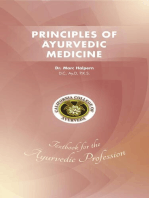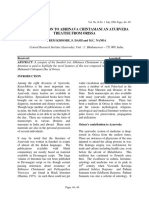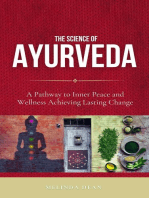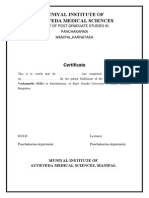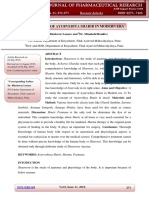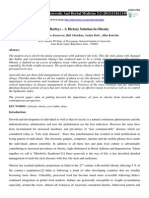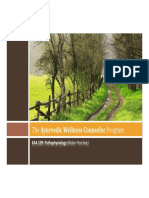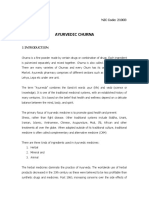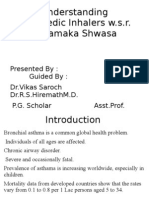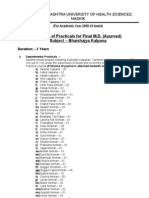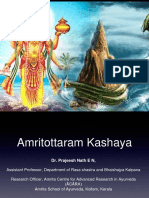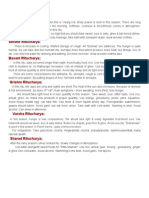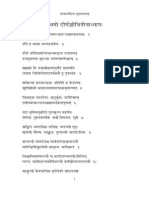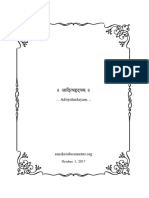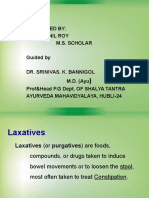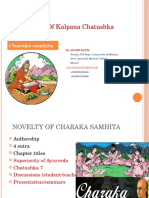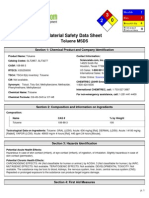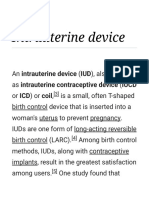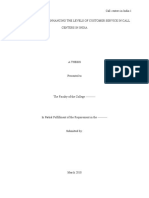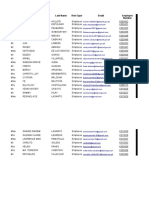Charaka Samhitha Critical Review
Charaka Samhitha Critical Review
Uploaded by
Samhitha Ayurvedic ChennaiCopyright:
Available Formats
Charaka Samhitha Critical Review
Charaka Samhitha Critical Review
Uploaded by
Samhitha Ayurvedic ChennaiOriginal Description:
Copyright
Available Formats
Share this document
Did you find this document useful?
Is this content inappropriate?
Report this DocumentCopyright:
Available Formats
Charaka Samhitha Critical Review
Charaka Samhitha Critical Review
Uploaded by
Samhitha Ayurvedic ChennaiCopyright:
Available Formats
www.jahm.
in
(ISSN-2321-1563)
Journal of Ayurveda and Holistic Medicine | August, 2013 | Vol 1 | Issue 5
GENERAL ARTICLE
CHARAKA SAMHITA: A CRITICAL REVIEW
DASS RANJIP KUMAR
Assistant Professor, Department of Panchakarma, MSM Institute of Ayurveda, BPS Mahila Vishwavidya, Khanpur Kalan, Sonipat
(Haryana)
Corresponding author: email address : [email protected]
Access this article online : www.jahm.in
Published by Atreya Ayurveda Publications, Ilkal-587 125 (India) All rights reserved.
Received on: 16/07/2013; Revised on: 03/08/2013; Accepted on: 09/08/2013
Abstract:
Charaka Samhita is a collection of various basic principles, healthy advises and directions, teaching and
research methodology, anatomy and physiology of body, pharmacological actions of various drugs,
description of preventive, promotive and curative aspects of various diseases along with panchakarma
chikitsa etc. For these great contributions, he has been known as father of medicine forever. He was
the only one great sage who has told about the two objectives of ayurveda i.e. 1) to maintain and
promote the positive health of healthy individuals 2) to cure the disease of diseased ones. Acharya
punarvasu atreya was the advisor and acharya agnivesha was the main author of charaka Samhita,
whereas acharya charaka was the actual redactor and acharya dridhabala was the completer of this
samhita.
Keywords: Ayurveda, charaka samhita, charaka
Introduction:
Ayurveda has been one of the ancient
sciences of life of the world going back to over
4,000 years BC, which is a branch of Atharva
Veda. It is an eternal science of healthy living
treasures deals with physical, psychological and
spiritual well being of the human being and
covers all the aspect of human life. It is not a
materialistic science but a philosophical and
factful truth, which enhanced by our great
ancient sages like Acharya Charak, Sushrut,
Vagbhatt etc. through their experience, logic and
power of wisdom.
Among these great sages, Acharya
Charak has a great contribution towards
Ayurveda by giving a great Literature
i.e.Charak Samhita, which is a collection of
various basic principles, healthy advises &
directions, Teaching & Research methodology,
anatomy & physiology of body,
pharmacological actions of various drugs,
description of Preventive, Promotive & Curative
aspects of various diseases along with
Panchakarma chikitsa etc. For these great
contributions, he has been known as Father of
Medicine for ever. He was the only one great
sage who has told about the two objectives of
Ayurveda i.e. 1) To maintain & promote the
positive health of healthy individuals 2) To cure
the disease of diseased ones. Here the Acharya
Punarvasu Atreya was the advisor & Acharya
Agnivesha was the main author of this Charak
Samhita, whereas Acharya Charak was the
actual redactor & Acharya Dridabala was the
completer of this Samhita.
The Charak Samhita consists of 8
sections (Sthan) and contains total 120 chapters,
9035 Sutras (formula) & 12,000 Slokas. Each
section contains some of chapters, sutras &
slokas. These 8 sections are as follows, viz. 1)
Sutrasthan (30 chapters) 2) Nidanasthan (8
chapters) 3) Vimanasthan (8 chapters) 4)
Sharirasthan (8 chapters) 5) Indriyasthan (12
chapters) 6) Chikitsasthan (12 chapters) 7)
Kalpasthan (12 chapters) and 8) Siddhisthan (12
chapters). Acharya Dridabala has completed the
redaction process of Charak Samhita by
Dass Ranjip Kumar: Charaka samhita: A critical review
Journal of Ayurveda and Holistic Medicine | August, 2013 | Vol 1 | Issue 5 21
redacting the last 17 chapters of Chikitsasthan,
total Kalpasthan & Siddhisthan, which were not
redacted by Acharya Charak.
The original Charak Samhita (Sanskrit
Version) is of one volume. But the currently
available Charak Samhita (Commentary of
various authors) is in two parts like Purvaardha
& Uttaraardha. Purvaardha contains 5 sections
(Sthan), viz. 1) Sutrasthan 2) Nidanasthan 3)
Vimanasthan 4) Sharirasthan 5) Indriyasthan and
Uttaraardha contains 3 sections, viz. 1)
Chikitsasthan 2) Kalpasthan 3) Siddhisthan.
Actually these available 2 parts are the Hindi
commentary of Charak Samhita, as different
commentaries in different languages like
English, Gujarati, Arabic, Persian etc are also
available which are written by different
Acharyas & learned Vaidyas.
The Sutrasthana is that section where a
collection of various important Sutras
(Ayurvediya formula) or Slokas related to
various context are described, for which it is,
also known as Slokasthan. This Sthan contains
1952 Sutras and 30 chapters which are divided
into 7 Chatuskas & 1 Sangrahadhyaya. Chatuska
means a division comprising of 4 chapters
relating to same topic. The first Chatuska is
Ausadha Chatuska comprising chapter no.1 to 4,
where description about various drugs & basic
principles of Ayurveda is available. Likewise the
2
nd
Chatuska is Swasthavritta Chatuska
comprising chapter no.5 to 8, where many
healthy advises is mentioned which are required
for maintaining the good health of healthy
individuals. Similarly the 3
rd
Chatuska is
Nirdesh Chatuska comprising chapter no.9 to 12,
where many important information & directions
related to Ayurveda is described. The 4
th
Chatuska is Kalpana Chatuska comprising
chapter no.13 to 16, where a no. of preparations
or ways of preparations related to Ayurvediya
drugs or various treatments are advised. The 5
th
Chatuska is Roga Chatuska comprising of
chapter no.17 to 20, where various types & no.
of diseases are mentioned. Likewise the 6
th
Chatuska is Yojana Chatuska comprising
chapter no.21 to 24, where the various types of
ways of treatment procedures of various
ailments are described. Similarly the 7
th
Chatuska is Annapana Chatuska comprising
chapter no.25 to 28, where the various types of
foods, food materials & various ways of
preparing food are told by Acharya Charak. The
Sangrahadhyaya comprising of the last two
chapter no.29 & 30, where the collection of
different characteristics of life, body &
physician (Vaidya) are elaborately described.
The Nidanasthan is that section which
contains 247 Sutras and 8 chapters where the
various Nidana (Etiology), Samprapti
(Pathogenesis), Purvarupa (Prodromal signs &
symptoms) and Rupa (Clinical features (signs &
symptoms)) of 8 Mahavyadhis (Diseases) like
Jwara (Fever), Raktapitta (Haemoptysis or
Haematemesis), Gulma (Abnormal growth),
Prameha (Diabetes), Kustha (Leprosy), Shosa
(Tuberculosis), Unmada (Insanity) and Apasmar
(Epilepsy) are elaborately described.
The Vimanasthan is that section which
contains 354 Sutras and 8 chapters where the
specific knowledge (Quantitative & Qualitative)
about Dosha (Ailments), Roga, Bhesaja (Drugs),
Desha, Kala, Bala, Sharira, Ahara, Sattwa,
Satmya etc. as well as their characteristics is
elaborately described. The detail description
about Srotas, Amashaya, Krimi Roga, various
Pramanas, Dasavidha Rogi Pareeksha (Ten
investigations regarding patients), 44 types of
Vaada (Debate), methods of study & teaching,
methods of Research, details of seminars &
symposium and Janapadadhwansa
(Epidemiology) are available in this section.
The Sharirasthan is that section which
contains 382 Sutras and 8 chapters where the
detail description about anatomy & physiology
of Sharira (Body), Garbha (Pregnancy (Sign &
Symptoms according to months), Monthly
development & nutrition of fetus, causes of fetal
death & treatment)), Prasava (Labour, Prenatal,
Natal & Postnatal care, Sutika Roga & its line of
treatment) etc. are available.
The Indriyasthan is that section which
contains 378 Sutras and 12 chapters where the
Arista Lakshanas (Prognosis of death) on the
basis of various descriptions regarding Swara
(Voice), Gandha (Smell), Rasa (Taste), Sparsha
(Touch), Swapna (Dreams), Chhaya (Shadow),
Dass Ranjip Kumar: Charaka samhita: A critical review
Journal of Ayurveda and Holistic Medicine | August, 2013 | Vol 1 | Issue 5 22
Pratichhaya (Reflected Shadowa), Prabha
(Lustre) & Sadyomaran (Quick death) and
Astamahagada (8 dreadful diseases) are narrated
very nicely.
The Chikitsasthan is that section which
contains 4904 Sutras and 30 chapters where the
detail description of various diseases & their
principles of treatment along with descriptions
of Rasayan & Vajikaran are available. Here the
1
st
chapter is related to Rasayan & the 2
nd
is
related to Vajikaran. Both chapters are described
according to 4 Paada (Paada have been told,
which denotes 1/4
th
of a chapter, so that 4 Paada
comprises one chapter). The various diseases
like Jwar, Raktapitta, Gulma, Prameha, Kustha,
Shosa, Unmada, Apasmar, Kshatakshina,
Shotha, Udara, Arsha, Grahani, Pandu, Shwasa,
Kasa, Atisara, Chhardi, Visarpa, Trishna, Bisa,
Madatyaya, Vrana, Marma, Urusthamba,
Vatavyadhi, Vatarakta & Yonivyapad and their
clinical features with different principles of
treatment (Shodhan (Panchakarma), Shaman
(Medicines) & Nidan Parivarjan (Avoiding the
causative factors)) are narrated very nice
manner, thats why Acharya Charak was famous
for Chikitsasthan (Charakastu Chikitsite)
The Kalpasthan is that section which
contains 378 Sutras and 12 chapters where the
different Kalpana (Churna, Kalka, Kwath,
Swaras etc.) of Vamana drugs (Emetics) like
Madanphala, Jimutak, Ikshwaku, Dhamargav,
Vatska (Kutaja), Kritavedhan and Virechana
drugs (Purgatives) like Shyama Trivrit,
Chaturangul (Aragvadh), Tilwak (Lodhra),
Sudha (Snuhi), Saptala-Sankhini & Danti-
Dravanti according to the stage of Dosha/Roga
& Rogi along with their pharmacological action,
dose, indications & contraindications are
described.
The Siddhisthan is that section which
contains 700 Sutras and 12 chapters where the
detail description of Panchakarma Chikitsa is
available. The different Karmas like Snehan,
Swedan, Vaman, Virechan, Asthapan Basti,
Anuvasan Basti, Uttarabasti, Shirovirechan etc
and their detail procedures, indications &
contraindications, advantages & disadvantages,
importance of various therapies along with 36
types of Tantrayukti, the disaease Mutraghata &
Shiroroga and the importance of Charak Samhita
are nicely & elaborately explained in this
section.
Cite this article as : Dass Ranjip Kumar. Charaka Samhita :
A critical review. Journal of Ayurveda and Holistic
Medicine 2013;1(5): 20-22.
Source of support : Nil. Conflict of interest : None declared
You might also like
- DR Off Limits - Louise BayDocument273 pagesDR Off Limits - Louise BayUnam NyilaNoch keine Bewertungen
- Aloe Ferox - in View of Ayurveda: A Critical Study of Aloe Ferox in Ayurvedic PerspectiveFrom EverandAloe Ferox - in View of Ayurveda: A Critical Study of Aloe Ferox in Ayurvedic PerspectiveNoch keine Bewertungen
- Samhita: Atreya PunarvasuDocument9 pagesSamhita: Atreya PunarvasuNikitha HabibNoch keine Bewertungen
- Srotomaya Shariram: Dr. Prasanna N. Rao Principal, SDM College of Ayurveda, Hassan-KaranatakaDocument21 pagesSrotomaya Shariram: Dr. Prasanna N. Rao Principal, SDM College of Ayurveda, Hassan-KaranatakaDrHemant ToshikhaneNoch keine Bewertungen
- Vierya Vipaka ProbhavaDocument7 pagesVierya Vipaka ProbhavaSN WijesinheNoch keine Bewertungen
- Everest AyurvedaDocument29 pagesEverest AyurvedaSamhitha Ayurvedic ChennaiNoch keine Bewertungen
- Meditation For Healing and To Make Your 9 Bodies WhiteDocument2 pagesMeditation For Healing and To Make Your 9 Bodies Whites100% (2)
- The Charaka SamhitaDocument23 pagesThe Charaka SamhitaAlex RiveraNoch keine Bewertungen
- Abhinava ChintamaniDocument7 pagesAbhinava ChintamaniBrad Yantzer50% (2)
- A Handbook On Ayurvedic Intranasal Drug Therapy: Nasya Karma ChikitsaFrom EverandA Handbook On Ayurvedic Intranasal Drug Therapy: Nasya Karma ChikitsaRating: 3.5 out of 5 stars3.5/5 (3)
- The Science of Ayurveda: The Ancient System to Unleash Your Body's Natural Healing PowerFrom EverandThe Science of Ayurveda: The Ancient System to Unleash Your Body's Natural Healing PowerNoch keine Bewertungen
- Going Towards the Nature Is Going Towards the Health; Gaining StrengthFrom EverandGoing Towards the Nature Is Going Towards the Health; Gaining StrengthNoch keine Bewertungen
- Concept of Shad Garbhakara Bhavas in Ayurveda: A Review ArticleDocument2 pagesConcept of Shad Garbhakara Bhavas in Ayurveda: A Review Articlesrikanth PosaNoch keine Bewertungen
- A Critical Review On Yogaraja GugguluDocument3 pagesA Critical Review On Yogaraja GugguluEditor IJTSRDNoch keine Bewertungen
- Introduction To Kaumarabhritya NewDocument13 pagesIntroduction To Kaumarabhritya Newsubin100% (2)
- 03 Vata VyadhiDocument49 pages03 Vata VyadhiAjay IyerNoch keine Bewertungen
- Santarpaniya Adhyaya - Charak SamhitaDocument216 pagesSantarpaniya Adhyaya - Charak SamhitaDavidd GuettaNoch keine Bewertungen
- Basti and NasyaDocument13 pagesBasti and NasyaAswathy KumaranNoch keine Bewertungen
- The Sushruta Samhita and Plastic Surgery in Ancient India, 6th Century B.C.Document4 pagesThe Sushruta Samhita and Plastic Surgery in Ancient India, 6th Century B.C.macovei003Noch keine Bewertungen
- Six UpakramaDocument5 pagesSix UpakramaAman TyagiNoch keine Bewertungen
- AyuDocument9 pagesAyuBala Kiran GaddamNoch keine Bewertungen
- Medicinal Properties of Various Types of Milk: An Ayurvedic ReviewDocument8 pagesMedicinal Properties of Various Types of Milk: An Ayurvedic ReviewYogesh DrallNoch keine Bewertungen
- What Is Nourishment According To Āyurveda - Vaidya Atreya Smith PDFDocument5 pagesWhat Is Nourishment According To Āyurveda - Vaidya Atreya Smith PDFpramodNoch keine Bewertungen
- Animal Health Care in Ancient IndiaDocument4 pagesAnimal Health Care in Ancient Indiaamirapu sureshNoch keine Bewertungen
- Concept of Immunity in AyurvedaDocument10 pagesConcept of Immunity in Ayurvedahari haraNoch keine Bewertungen
- Importance of Ayurveda SharirDocument7 pagesImportance of Ayurveda SharirHitesh LonareNoch keine Bewertungen
- Food CombiningDocument2 pagesFood Combiningmagda___Noch keine Bewertungen
- MAHATIKTAKAM GHRITAM - in Different ClassicDocument5 pagesMAHATIKTAKAM GHRITAM - in Different ClassicAyurvistaNoch keine Bewertungen
- Yava Barley A Dietary Solution in ObesityDocument5 pagesYava Barley A Dietary Solution in ObesityDigito DunkeyNoch keine Bewertungen
- Ayurvedic Health Care Journal Apr2020e1Document73 pagesAyurvedic Health Care Journal Apr2020e1Vijay Tripathi100% (1)
- Ayurvedacureofmalaria 1215102807546248 8Document18 pagesAyurvedacureofmalaria 1215102807546248 8Gian Prit Singh KhalsaNoch keine Bewertungen
- Guna Vikalpa in AyurvedaDocument22 pagesGuna Vikalpa in AyurvedaManoj Sankaranarayana100% (1)
- Ritucharya (ऋतुचर्या) - Ayurveda Recommended Seasonal Habits - Part 1Document18 pagesRitucharya (ऋतुचर्या) - Ayurveda Recommended Seasonal Habits - Part 1aarogya100% (1)
- Dinacharya - AnswersDocument7 pagesDinacharya - AnswersSanjay PisharodiNoch keine Bewertungen
- Concept of AgniDocument10 pagesConcept of AgniKartik SrinivasanNoch keine Bewertungen
- Skin Diseases Tvak Vikaras in Ayurveda PDFDocument131 pagesSkin Diseases Tvak Vikaras in Ayurveda PDFDr.Chetana I100% (1)
- Malas Are The MetabolicDocument34 pagesMalas Are The MetabolicallenNoch keine Bewertungen
- The Ayurvedic Wellness Counselor Program: KAA 109: Pathophysiology (Nidan Panchak)Document51 pagesThe Ayurvedic Wellness Counselor Program: KAA 109: Pathophysiology (Nidan Panchak)Anand YadavNoch keine Bewertungen
- Ayurvedic ChurnaDocument13 pagesAyurvedic ChurnaSabhaya Chirag100% (1)
- Shalkya TantraDocument3 pagesShalkya Tantratejpat2k7Noch keine Bewertungen
- Asava and ArishtaDocument7 pagesAsava and Arishtadrsa2Noch keine Bewertungen
- Understanding Ayurvedic Inhalers W.S.R. To Tamaka SwasaDocument15 pagesUnderstanding Ayurvedic Inhalers W.S.R. To Tamaka SwasaDrVikasNoch keine Bewertungen
- Charaka Samhita: Handbook On AyurvedaDocument100 pagesCharaka Samhita: Handbook On AyurvedaRaj GuptaNoch keine Bewertungen
- All KashaayamsDocument8 pagesAll KashaayamsSamhitha Ayurvedic ChennaiNoch keine Bewertungen
- Wound Healing Activity of Tamarindus Indica Linn SDocument9 pagesWound Healing Activity of Tamarindus Indica Linn Sbasu68Noch keine Bewertungen
- Brihat Dadimashtaka ChurnaDocument6 pagesBrihat Dadimashtaka ChurnaSamhitha Ayurvedic Chennai100% (1)
- Infertility Treatment in PCMC, Pimpri Chinchwad - Infertility Clinic in PCMC, Pimpri ChinchwadDocument10 pagesInfertility Treatment in PCMC, Pimpri Chinchwad - Infertility Clinic in PCMC, Pimpri ChinchwadDr. Avinash DeoreNoch keine Bewertungen
- 10 Best Ayurvedic Medicine For DiabetesDocument15 pages10 Best Ayurvedic Medicine For DiabetesshirishkpatilNoch keine Bewertungen
- Bhaishajya KalpanaDocument10 pagesBhaishajya KalpanavkasatiNoch keine Bewertungen
- Ayush PPT FinalDocument64 pagesAyush PPT Finaldr jayaNoch keine Bewertungen
- Management of Meniere's Disease - An Analytical Ayurveda PerspectiveDocument3 pagesManagement of Meniere's Disease - An Analytical Ayurveda PerspectiveAdvanced Research PublicationsNoch keine Bewertungen
- Amritottaram KashayamDocument11 pagesAmritottaram KashayamPrajeesh nathNoch keine Bewertungen
- Ritu CharyaDocument1 pageRitu Charyayuvi087Noch keine Bewertungen
- Ama Concept in AyurvedaDocument2 pagesAma Concept in AyurvedaRita LameirãoNoch keine Bewertungen
- Indus Valley EbookDocument56 pagesIndus Valley EbookKata KataNoch keine Bewertungen
- Kampa VataDocument27 pagesKampa VataAditya Tak100% (1)
- SUTIKA ROGA CHIKITSA (Treatment of Puerperal Disorders)Document25 pagesSUTIKA ROGA CHIKITSA (Treatment of Puerperal Disorders)Hot Works100% (1)
- Basics of Ayurvedic Pharmacology (Dravya Guna Vignana)Document3 pagesBasics of Ayurvedic Pharmacology (Dravya Guna Vignana)SN Wijesinhe100% (1)
- Charaka Samhita, Sutrasthanam, Slokas The Section of Introductory, Theoretical and Philosophical Foundation of AyurvedaDocument240 pagesCharaka Samhita, Sutrasthanam, Slokas The Section of Introductory, Theoretical and Philosophical Foundation of AyurvedaAyurvista89% (9)
- Galactagogue Effect BananaflowerDocument7 pagesGalactagogue Effect BananaflowerSamhitha Ayurvedic ChennaiNoch keine Bewertungen
- Various Uses of BananaDocument4 pagesVarious Uses of BananaSamhitha Ayurvedic ChennaiNoch keine Bewertungen
- Khalitya (PPTminimizer)Document12 pagesKhalitya (PPTminimizer)Samhitha Ayurvedic ChennaiNoch keine Bewertungen
- 2115 Kshudrakusta-VicharchikaDocument3 pages2115 Kshudrakusta-VicharchikaSamhitha Ayurvedic ChennaiNoch keine Bewertungen
- Sthoulya ObesityDocument205 pagesSthoulya ObesitySamhitha Ayurvedic Chennai100% (1)
- .. Adityahridayam ..: October 1, 2017Document14 pages.. Adityahridayam ..: October 1, 2017Samhitha Ayurvedic ChennaiNoch keine Bewertungen
- Brihat Dadimashtaka ChurnaDocument6 pagesBrihat Dadimashtaka ChurnaSamhitha Ayurvedic Chennai100% (1)
- Prelude TP DiabetesDocument2 pagesPrelude TP DiabetesSamhitha Ayurvedic ChennaiNoch keine Bewertungen
- Avarana in VyadhiDocument4 pagesAvarana in VyadhiSamhitha Ayurvedic ChennaiNoch keine Bewertungen
- Diet & GrahaniDocument6 pagesDiet & GrahaniSamhitha Ayurvedic ChennaiNoch keine Bewertungen
- Agada-Past Present FutureDocument3 pagesAgada-Past Present FutureSamhitha Ayurvedic Chennai100% (1)
- SubhashithaaniDocument65 pagesSubhashithaaniSamhitha Ayurvedic ChennaiNoch keine Bewertungen
- Sanskrit Transliteration TablesDocument9 pagesSanskrit Transliteration TablesSamhitha Ayurvedic ChennaiNoch keine Bewertungen
- LaxativesDocument35 pagesLaxativesSamhitha Ayurvedic ChennaiNoch keine Bewertungen
- Therapeutic Index - FinalDocument41 pagesTherapeutic Index - FinalSamhitha Ayurvedic ChennaiNoch keine Bewertungen
- AmavataDocument14 pagesAmavataSamhitha Ayurvedic ChennaiNoch keine Bewertungen
- Avrutavata and Its ChikitsaDocument3 pagesAvrutavata and Its ChikitsaSamhitha Ayurvedic ChennaiNoch keine Bewertungen
- Panca MahabhutasDocument13 pagesPanca MahabhutasSamhitha Ayurvedic ChennaiNoch keine Bewertungen
- All KashaayamsDocument8 pagesAll KashaayamsSamhitha Ayurvedic ChennaiNoch keine Bewertungen
- Chitraka Sodhana ResearchDocument6 pagesChitraka Sodhana ResearchSamhitha Ayurvedic ChennaiNoch keine Bewertungen
- Dranandkatti 150909085145 Lva1 App6892Document46 pagesDranandkatti 150909085145 Lva1 App6892Samhitha Ayurvedic ChennaiNoch keine Bewertungen
- Drivers Handbook: March 2005Document48 pagesDrivers Handbook: March 2005candie marangaNoch keine Bewertungen
- Odisha Merit List Round TwoDocument109 pagesOdisha Merit List Round TwoShekhar BeheraNoch keine Bewertungen
- Overdenture 4th Year 15-3-2020Document52 pagesOverdenture 4th Year 15-3-2020Ahmed AliNoch keine Bewertungen
- Mid TermDocument4 pagesMid TermKhánh Nguyễn Trường QuốcNoch keine Bewertungen
- Referral Emergency Letter PDFDocument1 pageReferral Emergency Letter PDFfayas mohammedNoch keine Bewertungen
- Project Bali - General Teaser H3-H6 Jul23 (4) (Jack)Document12 pagesProject Bali - General Teaser H3-H6 Jul23 (4) (Jack)Rose RaniNoch keine Bewertungen
- Corona Virus Project (Covid 19)Document20 pagesCorona Virus Project (Covid 19)Agbede Oluwadamilare BenjaminNoch keine Bewertungen
- ACT Handout RDW - 2023Document16 pagesACT Handout RDW - 2023Cs ChiaraNoch keine Bewertungen
- Final ToR For PCB MGT Project - ESIA Study.Document17 pagesFinal ToR For PCB MGT Project - ESIA Study.melkamuNoch keine Bewertungen
- Refrigeration in Food ProcessingDocument9 pagesRefrigeration in Food ProcessingsureshNoch keine Bewertungen
- Msds TolueneDocument6 pagesMsds Toluenenirmal_subudhi100% (1)
- National AEFI Surveillance and Response Operational Guidelines 2024Document316 pagesNational AEFI Surveillance and Response Operational Guidelines 2024Vandana VindalNoch keine Bewertungen
- Đề kiểm tra Friends Global GRADE 11 - UNIT 3 - TEST 2 - ĐỀDocument3 pagesĐề kiểm tra Friends Global GRADE 11 - UNIT 3 - TEST 2 - ĐỀNguyễn Ngọc Yến ThanhNoch keine Bewertungen
- Communicable Diseases What To Do About Lyme DiseaseDocument3 pagesCommunicable Diseases What To Do About Lyme DiseaseahiNoch keine Bewertungen
- Position PaperDocument2 pagesPosition PaperGroovy모니카Noch keine Bewertungen
- EUPIA March 2021Document6 pagesEUPIA March 2021Ellen De Oliveira DeNoch keine Bewertungen
- tiếng anh 8 unit 9 btDocument4 pagestiếng anh 8 unit 9 btLinh HuỳnhNoch keine Bewertungen
- Intrauterine Device - WikipediaDocument80 pagesIntrauterine Device - WikipediaDarshan MvNoch keine Bewertungen
- Bài-tập-Tiếng-Anh-7-Ms PhuongDocument143 pagesBài-tập-Tiếng-Anh-7-Ms PhuongJenny NgoNoch keine Bewertungen
- Call Care Centers - A ThesisDocument74 pagesCall Care Centers - A ThesisHerbertNoch keine Bewertungen
- Men's Health PDFDocument100 pagesMen's Health PDFRkarwal Karwal100% (4)
- 2nd Year Medical BooksDocument3 pages2nd Year Medical Bookskent_mazawNoch keine Bewertungen
- Crittenden Trauma ResilienceDocument35 pagesCrittenden Trauma ResiliencemunsifzmiNoch keine Bewertungen
- School-UACF-PERM v4 HigherDocument1,681 pagesSchool-UACF-PERM v4 HigherLawrence Mae CalaguingNoch keine Bewertungen
- Member List Website - 16-06-2017Document4 pagesMember List Website - 16-06-2017NJ enterpriseNoch keine Bewertungen
- Walden University Dissertation SamplesDocument6 pagesWalden University Dissertation SamplesNeedSomeoneToWriteMyPaperForMeWestValleyCity100% (2)
- Mg4012 Naf c00486 Civ Mts 0002 - 02 - Method Statement For Anti Termite WorksDocument13 pagesMg4012 Naf c00486 Civ Mts 0002 - 02 - Method Statement For Anti Termite WorksSagar AliasjackeyNoch keine Bewertungen
- (Most Essential Learning Competency: Describe The Feedback Mechanisms Involved in Regulating Processes in The Female ReproductiveDocument2 pages(Most Essential Learning Competency: Describe The Feedback Mechanisms Involved in Regulating Processes in The Female ReproductiveShane GendranoNoch keine Bewertungen
